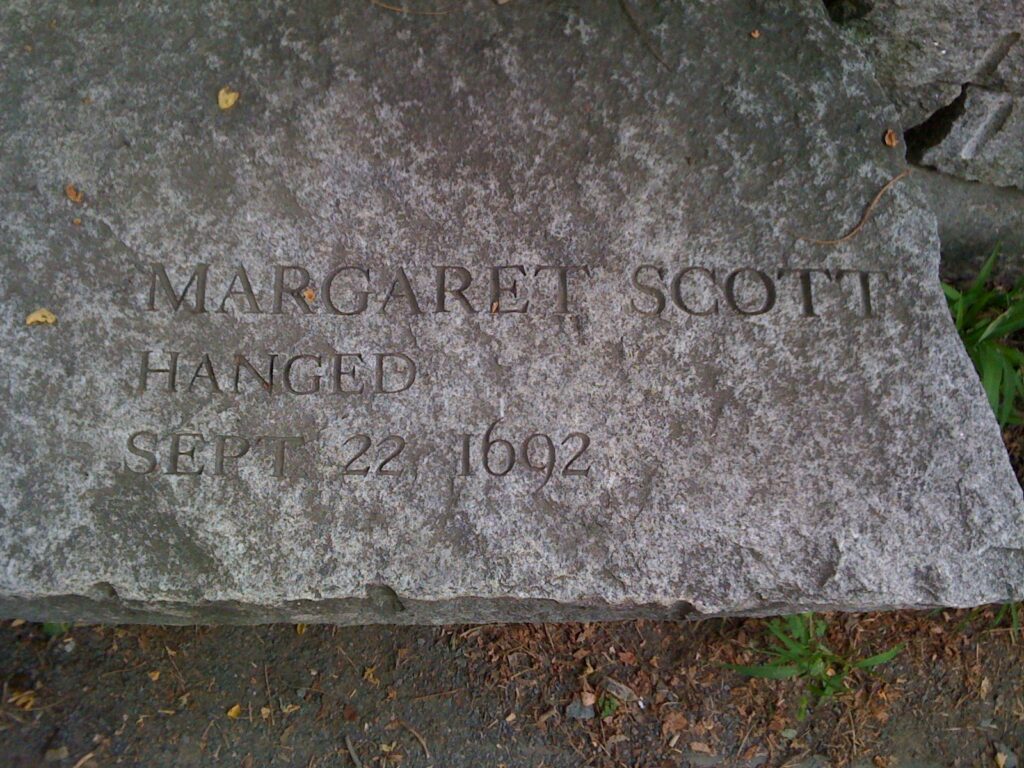Margaret Scott was one of the victims who were accused and executed in the last mass execution during the Salem Witch Trials. She would be executed on September 22, 1692, in an unmarked grave.
She was a prime candidate to be accused of being a witch. Unlike the other seven that would hang next to her, she was poor, a widow, and had lost several children in infancy. She had been reduced to begging by the time the Salem Witch Trials had begun. She was similar to the previous victim, Sarah Good.
Early Life and Family of Margaret Scott
Margaret migrated to Massachusetts Bay Colony from England with her parents sometime before 1642. She married Benjamin Scott, who had a lower status, and went on to have seven children with each other.
However, tragedy strikes the couple, and like many, they would have to endure the death of many children, as only three would survive until adulthood.
The town of Rowley granted Benjamin land in 1664. Shortly after, he was declared a freeman. Benjamin died in 1671, leaving an estate of only 67 pounds and 17 shillings, which would have to support Margaret and her family for the rest of her life, as she never remarried.
Impoverished, she would be reduced to begging.
Trial and Execution
Margaret was arrested late in the course of the events as part of the Andover witch hunt. Mary Walcott and Ann Putnam, Jr. had been brought to Andover on June 11 and again on July 26 to initiate and perpetuate the witch hunt there. Margaret's primary accusers were the two most prominent families in Rowley, the Nelsons and the Wicoms.
There is not much that remains of Margaret's trial. However, it is believed that after the accusations, she was most likely arrested the same and eventually brought before the judges to be examined.
The accusations against Margaret Scott were full of spectral evidence, most of which had "allegedly" taken place years prior.
Some of the accusations that were thrown against her that became proof of her being a witch were as follows:
- Frances Wicom claimed that she had been afflicting her since the first session of court and had continued to afflict her during her examination.
- The Nelsons said that Margaret was afflicting Roberto Shilleto 2 or 3 years ago.
- John Burbank went even further to say that 5 or 6 years ago, Margaret Scott had told him he would not be able to remove his corn from the field, and when he went to harvest his corn, his ox would not move.
- Daniel Wicom confirmed John's story by saying he had overheard the conversation take place...5 or 6 years ago.
The Nelsons and Wicoms continued to pile on the accusations without being cross-examined. The judges allowed evidence that was hearsay and circumstantial. The absurdity of these claims did not seem to matter, and the court took it as fact.
Margaret Scott would have had a hard time proving her innocence due to what the court allowed to be heard.
Unfortunately, her response to these accusations is not recorded, but it is known that she was convicted and that she did hang on September 22, 1692.

Like many others, she would be exonerated on October 31, 2001.
Those who died alongside her were as follows:
- Martha Corey (September 22, 1692; wife of Giles Corey)
- Mary Easty (September 22, 1692)
- Mary Parker (September 22, 1692)
- Alice Parker (September 22, 1692)
- Ann Pudeator (September 22, 1692)
- Wilmot Redd (September 22, 1692)
- Samuel Wardwell Sr. (September 22, 1692)
This would be the last mass execution during the Salem Witch Trials. Folks would begin to turn, and pastors from outside Salem began to question the logic and procedure that was being used during the trials.
